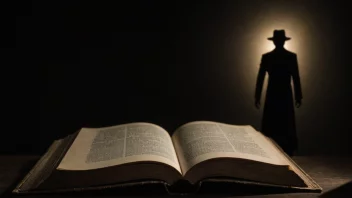Isolation is a powerful theme that resonates deeply within the realm of thriller literature. It serves not only as a backdrop for tension and suspense but also as a catalyst for character development and plot progression. From chilling psychological thrillers to heart-pounding mysteries, the motif of isolation can create an atmosphere ripe for fear, distrust, and revelation. This article delves into the multifaceted nature of isolation in thriller narratives, examining how different authors have utilized this theme to evoke emotion, drive conflict, and challenge the boundaries of the human psyche.
Defining Isolation in Thrillers
Isolation can manifest in various forms within thriller narratives. It can be physical, social, emotional, or psychological, and each type serves a unique purpose in shaping the story. Physical isolation might involve characters who are stranded in remote locations, while social isolation could depict individuals cut off from friends and family. Emotional and psychological isolation often explores the internal struggles of characters who feel disconnected from the world around them. The thrill of the narrative often lies in how these forms of isolation interact and evolve throughout the story.
The Psychological Impact of Isolation
One of the most compelling aspects of isolation in thrillers is its psychological impact on characters. Authors frequently use isolation to explore the fragility of the human mind when faced with extreme circumstances. In Patricia Highsmith’s The Talented Mr. Ripley, for example, the protagonist Tom Ripley experiences a profound sense of isolation fueled by his desire for acceptance and belonging. As he navigates through deception and crime, his isolation becomes both a source of strength and vulnerability, showcasing the duality of the human experience.
Character Development Through Isolation
Isolation often serves as a crucible for character development. As characters grapple with their solitude, readers are granted insight into their motivations, fears, and evolving identities. In Gillian Flynn’s Gone Girl, the protagonist Amy Dunne’s isolation is intricately tied to her meticulous planning and manipulation. The isolation she creates allows her to orchestrate events from the shadows, ultimately highlighting the lengths to which individuals will go when they feel unheard or misunderstood.
Setting the Scene: Physical Isolation
Physical isolation is a common trope in thriller narratives, often employed to heighten suspense and create a palpable sense of danger. This can be seen in works like Agatha Christie’s And Then There Were None, where ten strangers are stranded on an island, cut off from the rest of the world. The physical barrier intensifies the psychological tension as paranoia sets in, leading to a cascade of mistrust and betrayal. The desolate setting amplifies the characters’ fears, demonstrating how a confined space can distort perceptions and fuel conflict.
Creating Atmosphere Through Isolation
Writers skillfully use isolation to craft atmospheric tension. The absence of external influences can lead to a heightened sense of dread, as characters confront their inner demons. Stephen King’s The Shining exemplifies this technique; the Overlook Hotel becomes a character in its own right, serving as a sinister backdrop that exacerbates the protagonist Jack Torrance’s descent into madness. The isolation of the hotel, combined with the snowy landscape, creates an oppressive environment that mirrors Jack’s internal turmoil.
Social Isolation: The Loneliness of Suspicion
Social isolation often plays a critical role in thrillers, portraying characters who are estranged from their communities or loved ones. This form of isolation can generate feelings of suspicion and paranoia, as seen in works like The Girl on the Train by Paula Hawkins. The protagonist, Rachel, is socially isolated due to her alcoholism and personal struggles, which distorts her perception of reality. Her isolation leads her to become embroiled in a web of intrigue and deception, emphasizing how social disconnection can skew one’s understanding of truth and trust.
Building Suspense Through Social Isolation
Social isolation can also serve as a plot device to build suspense. In The Woman in the Window by A.J. Finn, the protagonist Anna Fox is a recluse, confined to her home due to agoraphobia. Her isolation amplifies her sense of vulnerability, and as she becomes increasingly fixated on her neighbors, the tension escalates. The walls of her home become both a physical barrier and a psychological prison, demonstrating how isolation can warp reality and create an atmosphere of suspense.
Thematic Exploration: Isolation and Identity
Isolation in thrillers often prompts a deeper exploration of identity. Characters are frequently forced to confront who they are when stripped of societal expectations and external validation. The theme of isolation can lead to moments of profound self-discovery, as seen in novels like Shutter Island by Dennis Lehane. The protagonist, Teddy Daniels, grapples with his memories and identity while navigating the isolating environment of a mental institution. The isolation serves as a catalyst for revelations about his past and the nature of his psyche, ultimately challenging the reader’s understanding of sanity and truth.
Isolation as a Means of Control
In many thrillers, isolation is used as a means of control, both by antagonists and within the characters themselves. The manipulation of isolation can create power dynamics that drive the plot forward. For instance, in Misery by Stephen King, the character Paul Sheldon is physically isolated and held captive by his obsessive fan Annie Wilkes. This isolation becomes a tool for Annie to exert control over Paul, showcasing how isolation can be wielded as a weapon against individuals. The tension between captivity and the longing for freedom illustrates the psychological complexities of power and dependency.
Literary Trends: The Evolution of Isolation in Modern Thrillers
As societal norms and technology evolve, so too does the portrayal of isolation in thriller narratives. The rise of digital communication has introduced new dimensions of isolation, with characters experiencing disconnection in an increasingly interconnected world. Modern thrillers often explore themes of virtual isolation, where characters may feel alone despite being surrounded by technology and social media. This contemporary take on isolation reflects the complexities of modern life, as seen in novels like The Circle by Dave Eggers, which critiques the isolating effects of social media on human relationships.
Global Perspectives on Isolation
Isolation is a theme that transcends cultural boundaries, and authors from around the world have explored its implications in unique ways. For instance, in the psychological thriller My Name is Lucy Barton by Elizabeth Strout, the protagonist’s reflections on her relationship with her mother reveal the emotional isolation that can exist within familial ties. This exploration of isolation resonates universally, highlighting how literature can bridge cultural gaps and foster understanding.
Conclusion
Isolation remains a compelling and multifaceted theme in thriller narratives, offering authors diverse avenues to explore the human psyche and societal dynamics. From psychological torment to physical confinement, the various forms of isolation create a rich tapestry that enhances tension and propels character development. As readers engage with these narratives, they are invited to reflect on the complexities of connection and disconnection, ultimately deepening their appreciation for the intricacies of the human experience. As the genre evolves, the theme of isolation will continue to challenge and captivate audiences, ensuring its place at the heart of thrilling literature.






